
by Alessia Leibert
March 2017
Completing more than one post-secondary degree can boost earnings only if it helps people move up a career ladder.
The economic return of higher education is not always the result of earning just one credential. For example, students who complete a transfer-oriented associate degree program harness the full value of their credential only after completing a bachelor's and perhaps even a master's degree.
This study explores the topic of stackable credentials with two goals. The first goal is to measure the extent of stacking in Minnesota. The second goal is to identify which credentials require additional higher education for their full market value to emerge.
The U.S. Department of Labor defines a credential as stackable when it belongs to "a sequence of credentials that can be accumulated over time to build up an individual's qualifications. Typically, stackable credentials help individuals move up a career ladder or along a career pathway to different and potentially higher-paying jobs."1
This concept of building workforce competencies block by block through shorter, more affordable credentials that help people progress through a career has become popular among higher education and job training professionals. Implicit in the concept is the idea that short training programs with low stand-alone market value can be leveraged as stepping stones to further education.
What looks good in theory may not be easy to realize in practice, however. For the investment to be worthwhile, educational credentials must lead to marketable skills, and associate degrees designed to transfer to a four-year program must lead to degree completion in that four-year program.
To measure the occurrence of credential stacking, we looked at how many students completed more than one type of award over time.2 Table 1 shows that 223,983 graduates completed an award up to a bachelor's degree in Minnesota from July 2006 to June 2011. Of these, 15.9 percent subsequently earned one or more additional awards within four years of the first award.
| Summary of Educational Transitions, Classes of 2007-2011 | ||
|---|---|---|
| Type of Educational Transition | Number of Graduates | Percent |
| Earned a credential up to a bachelor's and did not complete any further credential in Minnesota within four years | 188,273 | 84.1% |
| Completed a second credential within four years | 35,710 | 15.9% |
| Total who completed a post-secondary credential by age 40* | 223,983 | 100.0% |
| * Some exclusions apply (see "About the Data" below). Students who took longer than four years to complete an additional award – representing 3.9 percent of the combined student cohorts – were also excluded to avoid skewing results in favor of the 2007-2008 cohorts who had more time to complete additional credentials. | ||
| Source: Minnesota Office of Higher Education post-secondary graduation records | ||
|
About the Data DEED Unemployment Insurance Program wage records and Minnesota Office of Higher Education post-secondary graduation records were the sources for all data in this article. These were linked together and cleaned to form the Workforce Data Quality Initiative (WDQI) database. The dataset includes the following:
The dataset excludes the following:
|
Why are educational transitions so uncommon? First, this measure slightly underestimates educational transitions because it excludes people who pursued further education outside the state. Second, the initial credential might have enough market value to make further education unnecessary. Third, students may not be aware of continuing education opportunities or may be discouraged by cost and/or hurdles of transferring credits.
Not all educational transitions can be considered "stacking." For credentials to be stackable, some of the technical coursework and credits earned from the first credential have to carry over to the second credential. When we apply these criteria, credential stacking affects even less than 15.9 percent of the selected cohorts.
Moving from a lower- to higher-level award is more common, accounting for 11.9 percent of graduates during the selected period (see Table 2). Completing an associate degree followed by a bachelor's degree is an example of upward transition.
| Type of Educational Transitions, Classes of 2007-2011 | ||
|---|---|---|
| Type of Educational Transition | Number of Graduates | Percent |
| No further credential within four years | 188,273 | 84.1% |
| Completed a second credential lower than the first (downward transition) | 3,487 | 1.6% |
| Completed a second credential of the same level as the first (horizontal transition) | 5,477 | 2.4% |
| Completed a second credential higher than the first (upward transition) | 26,746 | 11.9% |
| Total who completed a post-secondary credential by age 40 | 223,983 | 100.0% |
| Source: Minnesota Office of Higher Education post-secondary graduation records | ||
Does stacking pay off in terms of better labor market outcomes after graduation? To answer the question, we will identify specific degrees and majors where stacking is more common and track students' earnings over time to determine whether those who complete an additional credential earn higher wages than those who do not.
Transitions from a two-year to a four-year degree in the same field of study are the most common examples of stacking. Figure 1 presents three measures of labor market success for associate degree programs in four selected academic fields. These measures are:
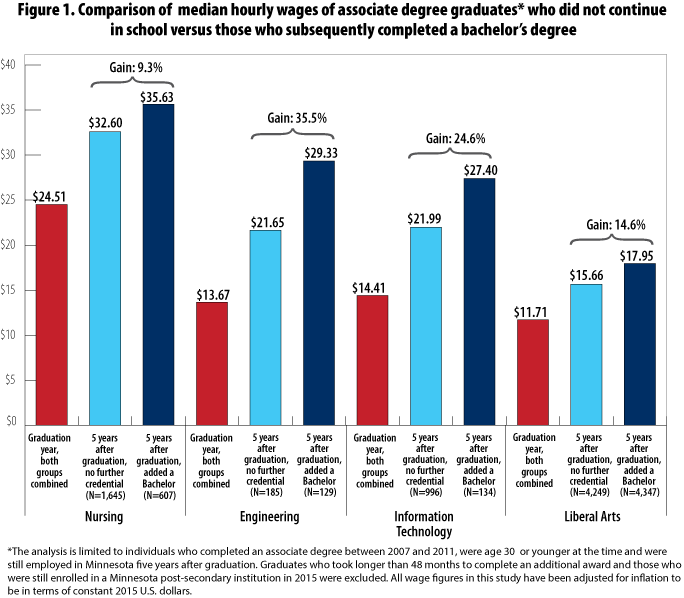
Marketability is highest in registered nursing, where hourly median wages of $24.51 indicate immediate employment as RNs. Wage growth over five years was strong, but those who stacked a bachelor's onto an associate degree had only a 9.3 percent wage advantage over the non-stacking group. The full added value of a bachelor's degree is realized by continuing to a master's degree, which enables entry into advanced practice nursing careers. 3
An associate degree is fairly marketable in the field of information technology, with median hourly wages of $14.41 at graduation. Those who moved on to a bachelor's degree, mostly concentrating in IT, earned 24.6 percent higher wages five years after graduation compared with those who stopped at a two-year degree.
The highest added value of a bachelor's degree seems to occur in engineering, where bachelor's completers, predominantly majoring in engineering, earned one-third (35.5 percent) more than those who did not continue. This result must be interpreted carefully. Since entry into the engineering profession requires a four-year degree, most students enroll directly in a four-year degree program. Completing the first two years of higher education at a community college and then transferring to a four-year degree might delay career entry but can reduce the overall cost of a bachelor's degree.
In liberal arts, a program specifically designed to transfer to a four-year degree, a large number of students, 4,249, either did not continue in school or transferred but did not enroll in 2015. These individuals missed or delayed an opportunity for stacking. Five years after graduation this group earned a median hourly wage of $15.66 while those who continued on to a bachelor's earned $17.95, a net difference of 14.6 percent. The earnings gain from further education was actually higher, 19.5 versus 14.5 percent, for continuing students who completed a bachelor's degree in a vocational/technical field (see Figure 2). Those who pursued a humanities field4 did not experience any increase in wages five years after graduation compared to those who stopped at an associate degree.
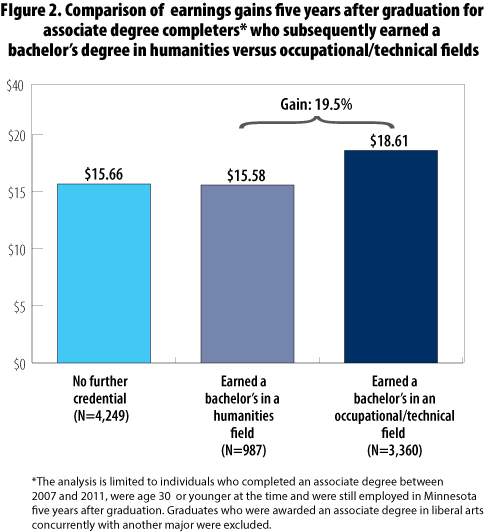
The full returns on a liberal arts degree were realized by completing a bachelor's degree in an occupationally oriented field, for example accounting. Although wages should not be the only factor used to justify additional levels of education, when the benefits from future earnings do not outweigh the costs of extra schooling, economic security might be at stake.
This evidence suggests that students who are not likely to transfer should be encouraged to enroll in programs that pay off at the associate degree level, and those who plan to transfer should choose their bachelor's major carefully.
Credentials stacking is more common within the same major because all technical coursework and credits earned in the first award carry over to the next. Figure 3 presents the outcomes of stacking credentials in automotive mechanics technology. The wage growth measure from graduation to five years after illustrates how outcomes varied between those who stacked, represented by the dotted line, and those who did not, represented by the solid line.
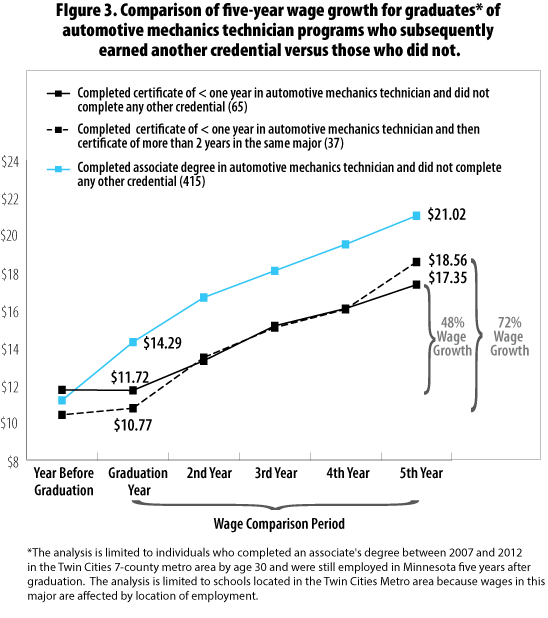
Short-term certificates in this field have good payoffs, leading to 48 percent wage growth and hourly wages of $17.35 even without further education. Those who subsequently earned a long-term certificate experienced 72 percent wage growth. Although the wage difference in the fifth year is small, it is enough to demonstrate that, in this particular field, completing additional coursework can help individuals qualify for higher paying, more professional positions. We expect this to be the case because the automotive service technicians and mechanics occupation typically requires post-secondary education and provides different employment opportunities at each credential attainment level.
Are students in this field better off by starting with an associate degree or by completing a sequence of certificates? As shown in the graph, associate degree completers earned $14.29 per hour upon graduation. After five years, they still held a solid wage advantage over certificate holders. Those who stacked two certificates started catching up, however. Although we'd need more years of data to determine whether the outcomes from stacking are equivalent to an associate degree, stackable certificates are a viable alternative for people who cannot commit to a two-year degree and need flexibility to complete at their own pace.
Shorter certificates are often designed to help students who lack the time or financial resources to commit to a longer-term degree. By offering more short-term credentials, schools can increase completion rates, and students who fail to complete the longer award theoretically benefit from having a recognizable shorter credential to fall back on. Breaking down an educational pathway into smaller chunks, however, is valuable only when each chunk leads either to further education or employment at family-supporting wages. Unfortunately some training programs do not perform well from either perspective.
Figure 4 presents wages of certificate holders in child development and related services, including programs in child care provider and child care management. Those who stopped at a certificate, whether short or long in duration, were still earning poverty wages five years after graduation. The few who stacked towards an associate degree (see dotted lines in Figure 4) experienced higher wage growth, at 29.4 percent, but ended up with hourly wages below $15.
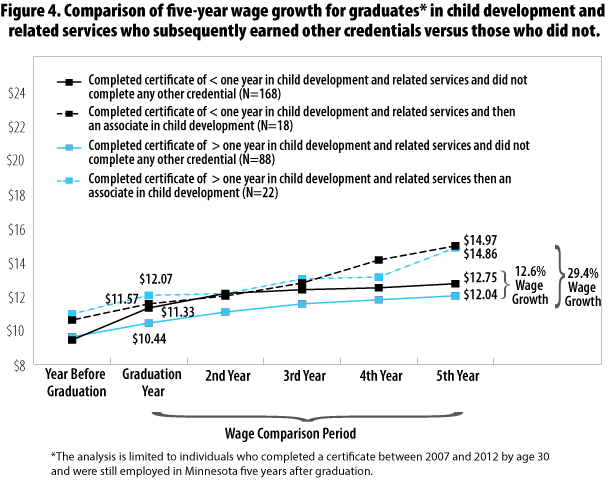
Figure 5 tracks people who started from an associate degree in child development and related services. The results confirm the findings in Figure 4. Associate degrees in this field do not pay off unless leveraged toward a bachelor's, yet only 40 people completed this transition and only 16 in a field related to early childhood. The 13 people who majored in early childhood education and teaching experienced the best results, moving from $10.29 to $18.70 per hour (81.7 percent growth in wages) because a bachelor's degree from an approved training program allows completers to pass a licensing exam and work as public school preschool teachers.5
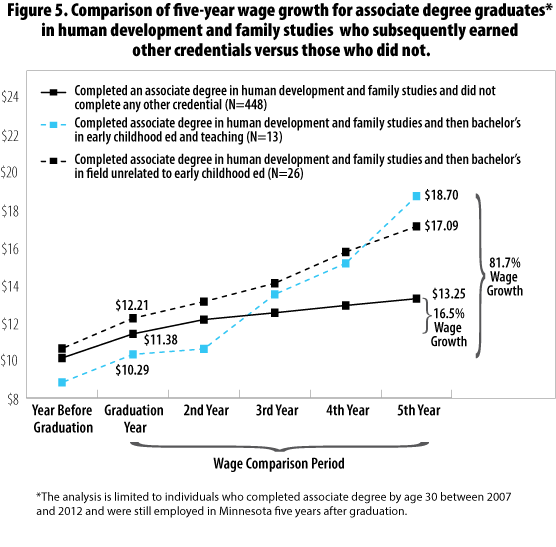
Since there is no road to a teaching career for people who fall short of a four-year degree, either the associate degree must be redesigned to enhance transferability or graduates will remain stuck in jobs that do not require college.
Employers, on the other end, have an important role to play in professionalizing their industry. If day care centers and other early childhood education service providers want to increase the quality of their workforce, they should establish career ladders and pay a wage premium to college-educated staff. This would encourage more people to enter and persist in early childhood-related academic fields. It is hard to justify investing in higher education when credential holders end up competing for the same jobs and wages as those without a degree.
Comparing the outcomes of short-term programs in automotive mechanics technologies versus those in child development is instructive. In the first case, the credential is valued by employers, and continuing on to a longer certificate helps people advance along a career path. In the second case, the credential is neither immediately marketable nor effective as a stepping stone to the degree necessary to career advancement – a bachelor's degree.
In general, certificates in the skilled trades and engineering technologies pay off even without further education, whereas certificates in service occupations, such as child care, bookkeeping, administrative assisting services or cosmetology, are less rewarded. The difference stems from the types of occupations the programs are designed to prepare for. Short-term programs with no evidence of marketability should be discouraged. Schools should monitor program performance and focus on ensuring that students succeed in programs that independently offer enough labor market payoffs to justify the cost of schooling.
Although credential stacking across fields of study is rare, biology is worth mentioning. Biology graduates who stopped at a bachelor's degree experienced strong wage growth (52.8 percent) leading to a median hourly wage of $22 five years after graduation (see Figure 6). Those who continued on to a master's degree in biology slightly improved their earning power, but they were in the minority. Most continuing students switched to a health care-related program where the payoffs were often higher. The biology curriculum overlaps with health care programs, facilitating credit transfer – an example of stacking.
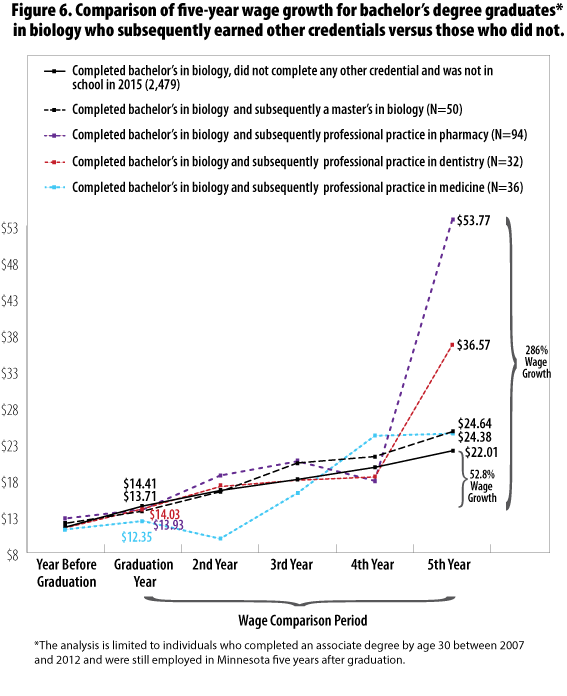
Graduates who continued on to a professional practice in dentistry and pharmacy experienced the strongest wage growth: 286 percent and 195 percent, respectively. Since these programs typically took at least four years to complete, a five-year horizon is not enough to appreciate the long-term wage effect. Medicine programs are particularly intense and leave little time for work, as can be seen from the initial declines in wages.
Health care programs are appealing to biology students because they can open the door to more remunerative careers, as shown in Figure 7. Health care programs, displayed inside the dark blue-colored boxes, prepare for jobs in large occupations with, typically, higher wages than the careers accessible through biology programs in the light blue boxes. The lines represent the actual movement of students who stacked these credentials.
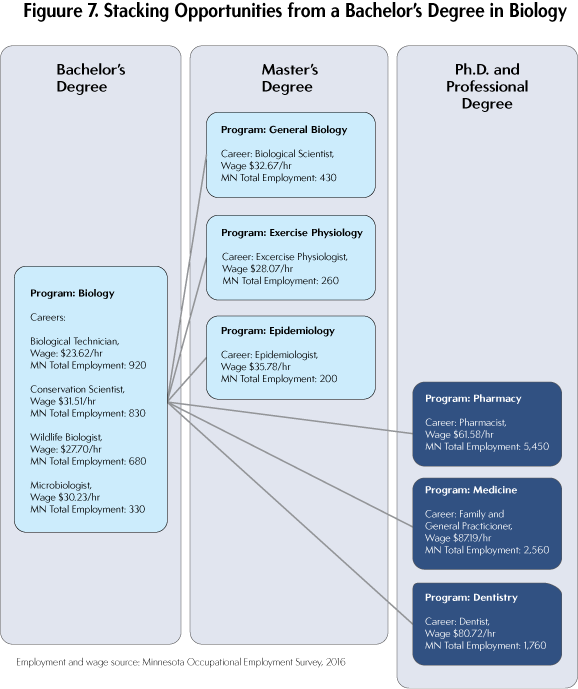
Such connections between program pathways are critically important because they allow people to enter careers that are in higher demand than those accessible from the majors of first choice. Schools should strive to facilitate transferability across programs and increase students' awareness of opportunities for stacking in areas that might otherwise be overlooked.
Horizontal transitions combine two credentials of the same level, theoretically enabling students to expand their skills and land higher paid jobs than those accessible through training in just one field. In practice, however, horizontal transitions often involve switching field of study and losing previously earned credits. Among associate and bachelor's degree completers who subsequently earned a degree of the same level (the horizontal transitions presented in Table 2), almost 10 percent switched to registered nursing. The effects of these transitions on wages are presented in Figure 8.
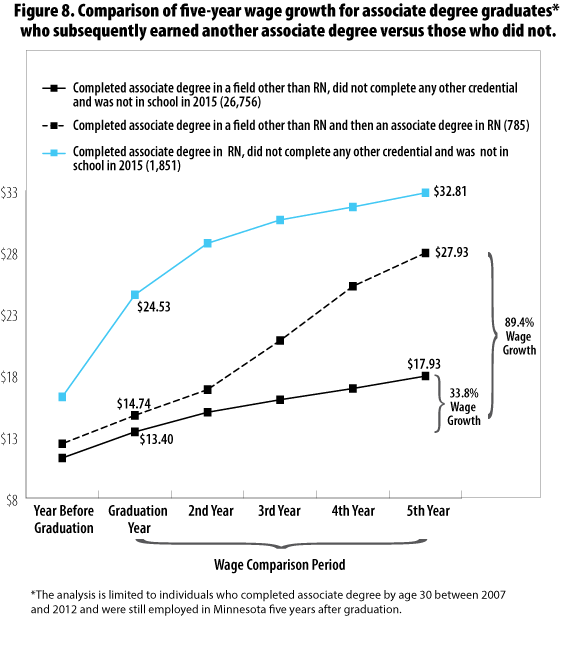
Associate degree holders who went back to school to complete a two-year registered nursing program experienced much more rapid earnings growth (89.4 percent versus 33.8 percent) than those who completed just one degree in a non-nursing field. These transitions do not meet the definition of stacking because coursework does not carry over from the first to the second credential and the sequence of training programs does not align with a career ladder.
Rather, they probably represent a change in career goals driven by the realization that registered nursing offers better job prospects compared with the major of first choice. Despite the notable improvement in labor market outcomes, people who pursued nursing as a second choice spent two more years in school and delayed career entry, a financially burdensome option. In comparison, those who entered an RN program directly were already earning $24.53 per hour upon graduation with wages climbing to $32.81 after five years.
Students should consult their academic advisers to make sure that their educational choices target careers where post-secondary education is compensated and market conditions are favorable.
Initiatives aimed at creating more entry and exit points into an educational pathway can help students enter the workforce sooner and with less debt. However, the evidence presented in this article – limited to young completers6 – shows that earning multiple post-secondary credentials helps only if employment opportunities exist at the different points of educational attainment.
The promise of stackable credentials may not play out in practice because educational attainment does not always translate into career mobility and better jobs. Students should think carefully about the options that are ahead. Is there a credential stacking option in the chosen academic field? Are earnings prospects enough to recoup the cost of more schooling? Are there good job opportunities if one decides not to pursue further education?
These findings lead to the following recommendations for schools, students and employers to expand the use and effectiveness of credentials-stacking in Minnesota:
In conclusion, for stackable credentials to be a viable option for students, higher education institutions should design their programs and pathways taking into account labor market conditions and students' outcomes. Employers also have an important role to play by partnering with schools to ensure that efforts to enhance stackability and portability of credentials translate into actual career readiness and advancement opportunities for students.
1U.S. Department of Labor guidance letter (TEGL-15-10) published Dec. 15, 2010.
2This research only looks at credit-bearing post-secondary awards excluding other types of credentials such as occupational licenses, apprenticeship certificates, and short skills certificates and certifications.
3A master's of science degree in nursing qualifies for licensure as nurse practitioner, nurse anesthetist and clinical nurse specialist.
4For the purpose of this analysis we defined humanities as liberal arts, foreign languages, philosophy, religion, interdisciplinary studies, letters/English, mathematics, fine arts, and social and behavioral sciences. This definition excludes science majors. Adapted from National Center for Education Statistics.
5The state of Minnesota requires public school preschool teachers to hold a bachelor's degree or higher from an approved early childhood education training program. Upon successful completion of an approved program and upon passing the Minnesota Teacher Licensure Examinations (MTLE) basic skills exam, one is eligible for licensure.
6A separate research would be needed to examine the labor market payoffs of stacking for older students who already have considerable work experience.
7DEED has developed the Graduate Employment Outcomes tool for use by prospective students/trainees as well as post-secondary institutions to evaluate the labor market alignment of Minnesota training and education programs.